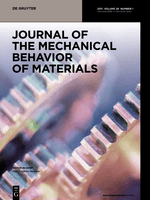
Revue des Composites et des Materiaux Avances-Journal of Composite and Advanced Materials
Scope & Guideline
Connecting Researchers with Cutting-edge Material Discoveries
Introduction
Aims and Scopes
- Composite Material Development:
The journal emphasizes the creation and enhancement of composite materials, including the exploration of new material combinations and innovative fabrication techniques. - Mechanical and Physical Properties Analysis:
A consistent focus on investigating and improving the mechanical, thermal, and physical properties of composites, ensuring they meet specific application requirements. - Nanocomposites and Advanced Materials:
Research on nanocomposites, which integrate nanoparticles into traditional materials to enhance their properties, is a core area of study. - Sustainable and Eco-Friendly Composites:
The journal promotes the exploration of sustainable materials, including the use of bio-based and recycled materials in composite formulations. - Application in Various Industries:
The journal covers applications of composite materials in diverse fields such as aerospace, civil engineering, biomedical devices, and electronics, highlighting their versatility. - Characterization Techniques:
Emphasis on the utilization of advanced characterization techniques to analyze the structure and performance of composite materials.
Trending and Emerging
- Biocomposites and Green Materials:
There is an increasing trend towards the development of biocomposites, which utilize natural fibers and bio-based polymers, emphasizing sustainability and environmental impact. - Smart and Functional Materials:
Emerging research focuses on smart composite materials that respond to environmental stimuli, indicating a growing interest in multifunctional applications. - Advanced Manufacturing Techniques:
Innovative manufacturing techniques such as 3D printing and additive manufacturing are becoming prominent, allowing for the creation of complex geometries and tailored properties. - Nanotechnology in Composites:
The incorporation of nanotechnology in composite materials is trending, with studies focusing on the effects of nanoparticles on enhancing material properties. - Thermal and Electrical Conductivity Studies:
Research exploring the thermal and electrical properties of composites is gaining attention, especially for applications in electronics and thermal management.
Declining or Waning
- Traditional Composite Materials:
There appears to be a reduction in studies focusing solely on traditional composite materials without incorporating innovative elements or advanced techniques. - Static Analysis Techniques:
Research employing purely static analysis methods for evaluating composite materials is becoming less frequent, as dynamic and computational approaches gain traction. - Basic Material Characterization:
While characterization remains important, there is less emphasis on basic characterization methods, with researchers increasingly favoring complex and multifaceted approaches. - Conventional Reinforcement Methods:
The exploration of conventional reinforcement methods, such as glass or carbon fiber without novel enhancements, is declining in favor of more innovative reinforcement strategies. - General Reviews on Composite Materials:
There is a noticeable decrease in the publication of general review articles on composite materials, suggesting a shift towards more focused and specific studies.
Similar Journals

JOURNAL OF THE MECHANICAL BEHAVIOR OF MATERIALS
Advancing Knowledge in Material BehaviorJOURNAL OF THE MECHANICAL BEHAVIOR OF MATERIALS, published by DE GRUYTER POLAND SP Z O O, is a prominent open-access journal in the field of materials science and mechanics, dedicated to facilitating the dissemination of high-quality research findings since 2019. With an ISSN of 0334-8938 and an E-ISSN of 2191-0243, this journal provides a platform for researchers, professionals, and students to explore the mechanical behaviors of various materials, crucial for advancing engineering and scientific applications. The journal's impact is evidenced by its impressive rankings, including Q2 status in both Materials Science (miscellaneous) and Mechanics of Materials as of 2023. With a Scopus rank placing it in the top-half of indexed journals, the JOURNAL OF THE MECHANICAL BEHAVIOR OF MATERIALS is a vital resource for anyone looking to stay at the forefront of material behavior research. Based in Germany, it serves the global academic community while catering to the evolving needs of industry practitioners through its comprehensive open-access model.

Letters on Materials
Connecting researchers with groundbreaking findings in materials science.Letters on Materials, published by the Russian Academy of Sciences, Institute of Metals Superplasticity Problems, serves as a vital platform in the diverse field of materials science. Established in 2014 and running through 2024, this journal has carved a niche as a Q3 category publication, focusing on innovative research and developments in materials science and engineering. With its ISSN 2218-5046 and E-ISSN 2410-3535, it provides a unique opportunity for researchers and industry professionals to disseminate significant findings and theoretical advancements within the materials domain. While currently not categorized as open access, the journal maintains a global reach, promoting scientific dialogue and collaboration particularly within the Russian Federation and broader international audiences. Its placement within the 25th percentile in the Scopus rankings underscores its emerging significance, making it essential reading for anyone interested in cutting-edge materials research.

MATERIALS AND MANUFACTURING PROCESSES
Advancing the Frontiers of Materials Science and Manufacturing Engineering.MATERIALS AND MANUFACTURING PROCESSES, published by Taylor & Francis Inc, is a leading journal dedicated to the dynamic fields of materials science and manufacturing engineering. Established in 1989, the journal has built a formidable reputation, exemplified by its prestigious Q1 rankings in 2023 across various categories, including Industrial and Manufacturing Engineering, Materials Science, Mechanical Engineering, and Mechanics of Materials. With a robust focus on innovative research and the latest advancements in manufacturing techniques and materials application, the journal serves as a vital resource for researchers, professionals, and students alike. The journal is indexed in renowned databases and boasts high impact factors, reflecting its influence in the academic community. Although it does not offer open access, it provides extensive platforms for disseminating crucial findings that push the boundaries of engineering and science. For those seeking impactful research contributions, MATERIALS AND MANUFACTURING PROCESSES remains at the forefront of fostering scholarly dialogue and advancing the field.

INTERNATIONAL POLYMER PROCESSING
Pioneering Research in the World of Polymers and PlasticsINTERNATIONAL POLYMER PROCESSING, published by WALTER DE GRUYTER GMBH, serves as a crucial platform for professionals and researchers in the fields of Chemical Engineering, Industrial and Manufacturing Engineering, and Materials Science, particularly focusing on polymers and plastics. With its ISSN 0930-777X and E-ISSN 2195-8602, this journal has been in circulation since 1988 and continues to expand its contributions to contemporary research trends through to 2024. Ranking in the third quartile across multiple categories, including Chemical Engineering (miscellaneous) and Materials Chemistry, it offers insightful and rigorous peer-reviewed articles that enhance the understanding of polymer processing technologies and innovations. This journal is vital for anyone engaged in polymer science and engineering, providing both theoretical and practical perspectives that advance the field. Although it does not provide open access, the journal's content is indispensable for academia and industry professionals looking to stay at the forefront of polymer research.

AIMS Materials Science
Unlocking Innovations in Material ResearchAIMS Materials Science is an esteemed open-access journal dedicated to advancing the field of materials science. Published by the American Institute of Mathematical Sciences (AIMS), this journal has been a vital resource for researchers, professionals, and students since its inception in 2014. With an ISSN of 2372-0468 and an E-ISSN of 2372-0484, it focuses on disseminating high-quality research in materials science, ranging from general materials science to cutting-edge advancements in innovative materials applications. Currently ranked Q3 in the 2023 Scopus Materials Science (miscellaneous) category, with a ranking of 253/463, AIMS Materials Science strives to provide an open forum for scholarly dialogue and collaboration, ensuring valuable insights are accessible to the global scientific community. The journal's commitment to open access enhances its visibility and reach, further promoting impactful research in this dynamic field.

GLASS AND CERAMICS
Driving Innovation in Materials Chemistry and MechanicsGLASS AND CERAMICS is a premier academic journal published by Springer, focusing on the vital fields of ceramics and composites, materials chemistry, and the mechanics of materials. Since its inception in 1956, this journal has contributed significantly to the advancement of knowledge and innovation in these domains, with a commendable 2023 Q3 quartile ranking in its categories. With an ISSN of 0361-7610 and an E-ISSN of 1573-8515, GLASS AND CERAMICS provides a platform for rigorous research and scholarly discussion, catering to a diverse audience of researchers, professionals, and students. Although the journal does not currently offer open access, it continues to disseminate vital insights that drive advancements in the materials science community. The journal’s commitment to high-quality research is underscored by its long-standing publication history and relevance in shaping future materials technology.

Frontiers in Materials
Connecting Researchers to Shape Tomorrow's Materials.Frontiers in Materials, an esteemed journal published by FRONTIERS MEDIA SA, is a leading platform in the field of Materials Science, with a notable impact factor placing it in the Q2 category of its discipline as of 2023. Since its establishment as an Open Access journal in 2014, it has fostered considerable academic exchange, allowing researchers from around the globe to share their innovative findings and insights. Based in Lausanne, Switzerland, this journal not only emphasizes high-quality peer-reviewed articles but also prioritizes rapid dissemination of research, as evidenced by its commendable Scopus ranking of #62 out of 196 in Materials Science (miscellaneous). By consistently striving to bridge the gap between academia and practical applications, Frontiers in Materials serves as an invaluable resource for researchers, professionals, and students seeking to delve into cutting-edge advancements and transformative applications in materials science.

Epitoanyag-Journal of Silicate Based and Composite Materials
Exploring the Future of Composite MaterialsEpitoanyag-Journal of Silicate Based and Composite Materials is a premier international journal published by the Scientific Society Silicate Industry-SZTE, focusing on the development and application of silicate and composite materials. With its Open Access policy established in 2013, this journal provides a platform for researchers, professionals, and students to disseminate and access high-quality research without barriers. The journal aims to foster advancements in the field by covering a broad spectrum of topics, including material characterization, innovative applications, and sustainability initiatives related to silicate-based and composite materials. Its commitment to sharing valuable research makes it an essential resource for those looking to stay at the forefront of material science. Located in Budapest, Hungary, the journal not only serves a global audience but also contributes to the ongoing dialogue within the materials science community.

MATERIALE PLASTICE
Unveiling the Potential of Advanced MaterialsMATERIALE PLASTICE is a distinguished academic journal published by REVISTA CHIMIE SRL in Romania, focusing on the fields of Chemistry, Materials Science, and Engineering. With an ISSN of 0025-5289 and an E-ISSN of 2668-8220, this journal has a historical commitment to advancing the study of polymers and plastics since its inception in the early 1970s. Although classified in the Q4 category across multiple disciplines including miscellaneous chemistry and materials chemistry as of 2023, it serves as an important forum for researchers and professionals dedicated to innovative materials research and development. The journal’s resources, though not openly accessible, are pivotal for scholars seeking to deepen their knowledge in the mechanics of materials and interdisciplinary applications. MATERIALE PLASTICE is not only a repository of significant research findings but also a platform for fostering collaboration and discussion among a global audience that continues to strive for scientific excellence in polymer and materials studies.

COMPOSITES PART A-APPLIED SCIENCE AND MANUFACTURING
Connecting Knowledge and Innovation in CompositesCOMPOSITES PART A-APPLIED SCIENCE AND MANUFACTURING, published by Elsevier Science Ltd, is a premier international journal that serves as a vital platform for the dissemination of high-impact research and innovation in the fields of composite materials and manufacturing technologies. With an impact factor that reflects its outstanding reputation, this journal is categorized in the Q1 quartile for both Ceramics and Composites and Mechanics of Materials, positioning it among the top journals in these disciplines. It holds impressive ranks in Scopus, specifically Rank #16 out of 398 in Engineering - Mechanics of Materials and Rank #10 out of 127 in Materials Science - Ceramics and Composites, reinforcing its authoritative stance in the field. Spanning from 1996 to 2024, the journal features a wide array of research articles, reviews, and case studies that collectively enhance understanding and foster advancements in composite materials. With an open access model facilitating wide dissemination, COMPOSITES PART A is indispensable for researchers, professionals, and students striving to push the boundaries of materials science and engineering.